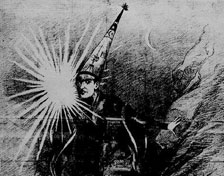talking history | syllabi | students | teachers | puzzle | about us
Thomas A. Edison Papers
http://edison. rutgers.edu
Created and maintained by the Thomas A. Edison Papers, Rutgers, The State University of New Jersey, Piscataway, N.J.; editor and director, Paul Israel.
Reviewed Jan. 3—13, 2003.
The Web site of the Thomas A. Edison Papers is an invaluable resource for professional historians and others interested in the renowned American inventor-entrepreneur. Although users only have direct access to a fraction of the Edison corpus, the site is an exemplar, one of the few destinations on the Web where a historian can conduct primary research from the comfort of his or her own home or office.

Edison as the Wizard of Menlo Park.
The holdings at the Edison National Historic Site in West Orange, New Jersey, contain an estimated 5 million pages of documents and include laboratory notebooks, patent applications, business and personal correspondence, and corporate documents spanning the six decades during which Edison was professionally active. Drawing upon extensive microfilms of selected records, the Edison Papers Web site provides online access to 180,000 items, and future plans call for doubling the online collection to approximately 400,000 documents.
In its current incarnation, the Web site is most useful to professional scholars familiar with the structure and operation of a modern archive. Its strengths are its rigor and depth: objects have been vetted and conformed; documents have permanent locators; and searches can be saved for future use. For many inquiries, using the Web site is preferable to accessing the original paper and microfilm archives. An extensive metadata coding scheme enables names, subjects, and document types to be searched on the fly. For first-time visitors, the “Document Sampler” section provides a good sense of the range of documents available, from patent applications and diary entries to poems and honorary degrees.
Many scholars will probably choose to use the Web site and paper archive in parallel. Because it is unlikely that the online collection will ever represent more than a fraction of the total archival holdings, projects will often require some interaction with documents that are not available online. In these instances, the Web site will serve as the most useful of finding aids, allowing researchers to make optimal use of time actually spent in West Orange.
Like all ambitious projects, the Edison Papers Web site is not without its limitations, and prospective users should be prepared for frustrations. First, the search function is overly complicated, necessitating a three-thousand-word user guide. Second, because only a small fraction of the total collection is available online, many searches produce the tantalizing experience of finding documents that cannot be immediately viewed. Third, given the richness of scholarship on Edison, the Web site is relatively light on general contextual information. Finally, because the documents have been scanned as .tiff (tagged image file format) files from microfilm, users can only search meta-data, not the data itself.
Relative to the extraordinary depth and breadth of the online collection, these complaints are minimal. Overall, the Thomas A. Edison Papers Web site is a research scholar’s treasure and a site that could easily be used to introduce upper-level undergraduates to the challenges of actually doing history.
David A. Kirsch
University of Maryland
College Park, Maryland
